American Sabbatical 051: 11/11/96
Los Angeles
11/11.. Los Angeles
Barstow is a remarkably integrated town, if our experience is any indication. In the restaurants on the
strip, both evening and morning, there were mixed crowds of Blacks,
Hispanics, Whites, and Orientals, all chowing down together in
family groups. Granted, they were all middle class, but it was
heartening nonetheless to encounter the whole stew in one pot.
The town itself was a sprawl bordered with railroad marshaling
yards, tank farms, some sort of refinery/mill, a solar water project,
and a Marine Corps Base. Beyond that the lone and level sands
stretch far away. This is the western terminus of the big dry
and dusty where even the cacti are shy and standoffish. We pulled
down our hatbrims and rejoined the road race.
Our final sprint across the desert was unremarked except by the
odd mountain rearing up like an island. One was framed by sweeping
catenary curves rising to crescendo at the peak, another, a perfect
black cone, had a spiral road climbing around it to some private
castle atop the nowhere. The fourwheelers and dirtbikes had left
linear scars thitherwhichaway. Then the Joshua trees started waving
their arms again and the scrub began thickening.
| We struck on dispersed development long before we raised any woody
growth, and turned off the interstate onto Pearblossom Highway
to skirt east of the San Bernardino mountains, and circle round
to West LA. It was a kick to be in a famous painting. David Hockney
did a fragmented photomontage image of a junction on the Pearblossom
Highway, with trash on the shoulder, and naked desolation to the
far reaches, and he got it right, heat shimmer and all. To our
left (west) the dark cordillera was capped with snow. |

Pearblossom Highway
(David Hockney Painting)
|
These are the unvarnished desert outskirts of The Big One, over
the outer ranges, and they have a seedy, outlaw ambiance. Trailers
and modest bungalows between abandoned hopes and thrift outlets.
“Antiques and Real Estate,” one opportunist advertised. The sideroads
deadended in junkyards or petered to dust. The few people in sight
looked worn out, and there was a glut of beaters. Even the road
was half-paved. But the Joshua trees were magnificent in abundance
and extravagant in choreography. There were patches of bunchgrasses,
and raptors coiled the air.

First Sightings
|
Then the traffic thickened, and the pace, as we merged first into
one freeway, then another: we had joined the Angeleno jostle.
The fourlane, then sixlane, then eightlane, swept up into the
San Gabriels and over Soledad Pass. The shrubs became trees, dense
stands of juniper, thick chaparral, then the hillsides opened
into mixed grasslands and desiccated shrubs. There had been fires
all through these hills, and black barrens yielded to thin washes
of bronze where the grasses had sprung back, and were now crisp
again. At one point we plunged between upheaved strata in a fractured
landscape that looked as though a quake had passed through yesterday.
Then we tipped headlong into the San Fernando Valley and the city
blossomed around us. |
Los Angeles is an hundred cities in one, spread along a coastal
plain, climbing the surrounding hills, pushing up the canyons,
spilling into the valleys beyond, and oozing out through the gaps
in the big mountains which drink the winds dry. The Valley is
where those kind of girls come from, and we were quickly in mega-urb
to the max. From stingy desert survivors to luxuriant irrigated
super-flora was an eyeblink, and a million Spanish castles bloomed
on the hillsides. Like, WOW.
| Once in the maelstrom it’s impossible to focus on the whirlingspast.
Cresting the last rise above the coastal metropoli the ocean smell
hangs in the yellowed air like an enticing incense, but you are
instantly bombarded with a cacophony of floral aromas, muddling
eye dazzles, and the intense lane-shuffle samba. California highway
signs are a casual after-thought, and the city was laid out by
road engineers who studied with Jackson Pollack. You can’t even
navigate by compass in this polis. No wonder the natives are so
dizzy. Fortunately I was traveling with a native (so many things
becomes clear), and she guided us up into the Brentwood hills
to the funky digs of Nina and Bill, the next victims of Muirinvasion. |
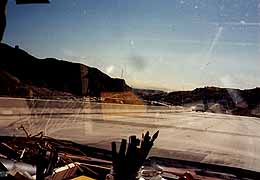
Onto the 8lane
|
Nina was Peggy’s college companion, and it’s fun for me to watch
the two of them shed the years together. She is a professor of
History at Occidental, he is a Physicist at UCLA. True scholars,
in the best of the academic tradition. Nina is just bringing to
publication a book about Louis the 15th’s official mid-wife, who
trained young women all over France in modern techniques of delivery
under a royal patent, and her narrative account of M. de Coudrey
is stylistically heretical, raising the hair of her colleagues.
So we had some dandy discussions on the nature of historical truth.
Nina says that narrative history is enjoying a renaissance after
a generation of dominance by the annalists who followed in Braudel’s
footsteps. This is to say that the story has recovered from the
onslaught of the database. Hurray the taletellers.
Bill and I politely waltzed around the dissonance of physics vs
metaphysics. I don’t see a necessary conflict between left and
rightbrain perceptions of reality, but Bill is convinced that
only Science is provable as truth (yes), and thus a valid subject
for analysis (no). I argued that art is the science of the spirit,
the perceptual focus which can reveal an inner universal truth.
That works of art which speak to an age are analogs of that era’s
scientific theories: windows on fundamental realities. It’s stimulating
to bump heads with eggnoggins. One of those urban sports.
Another is peoplewatching, and LA is the ultimate circus parade.
And a selfconscious parade, at that. This is the capital of bodybeautiful
and the simmer of mutual appraisal tingles even a jaded wanderer.
There are more anorexic joggers, curvaceous rollerbladers, hunks
in surfing suits, and sensuous strutters per square mile in LA
than anywhere else. But the costume show is so eclectic as to
be comical. Tights under floral miniskirts with highheel Doc martins
on matrons with pearls and Twenties hairstyles. Tie-dyed granny
dresses on inline skaters. Withered tanmasters in shorts and gold
chains wearing smoked sunglasses and clogs. Postmodern couture
in Santa Monica.
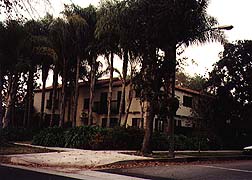
The babe's house
|
It goes with the architectural theme. Faux Chateau next Mock Tudor
side by Hacienda Moderne door to MaxiCape-and-El side to Cantilevered
Bau Haus. We revisited the house on Roxbury, in Beverley Hills,
that Peggy was born into, and it's a fanciful Spaniard in an overshadowing
grove of palms. Around the corner is the Witch’s House from a
children’s movie of the day, surrounded by monkey puzzles. If
buildings are signs in Vegas, they are movie sets in LA. And there
are a million movies in Tinsel Town. Nina and Bill’s cliffhanging
contemp is wound up at the top of Kenter Canyon in Brentwood,
on the western periphery of the megaburg, upcountry from Santa
Monica beach. Twentysome years ago it was a backwater bargain.
Now it’s an upscale address, and the local matrons wouldn’t chip
their nails with housework. What you see on the streets are nannies
strolling the offspring and Hispanic yardmen trimming the shrubbery..
and the joggers. |
| And the fab cars. Every dream vehicle you ever drooled over from
sexy sportscars to antique pickups, with a predominance of new
German high-tickets. These are the real outerwear of the Angelenos
and they drive with sartorial flair. The cutoff with head toss.
The sunbleached tousle in drag takeoff. There are surprisingly
few motorcycles for such a fairweather town, but I did glimpse
one immense black man in chains and stormtrooper helmet Harleying
fiercely down Sunset. |
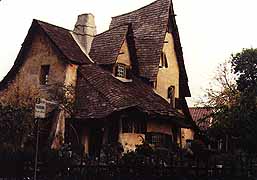
The witch's house
|
I have to admit that Red Owl has felt intimidated in all this
mechanical splendor. In fact, her brakes are failing. Having paid
through the nose for a complete brake overhaul before departure,
this is another indictment of Wiscasset Ford. May they all live
on the hilltops and depend by their own brake work. I get queasy
enough in the highclass altitudes, now I find them upright scareful.
We roar downhill in first gear with anxious Angelenos dodging
around us.
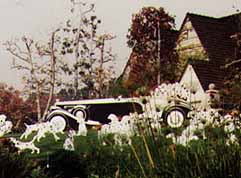
101
|
Our first evening in town we were booked in for dinner atop Beverley
Hills with an old friend of Peggy’s family. This is the top of
the pyramid, loyal readers, and the posh climbs to stratospheric
heights here. Street vendors peddle “star maps” for these streets.
It’s a silly game of higher upmanship on this storied slope, and
the houses themselves are, ironically, almost impossible to see.
Between the plantings, walls, and steep angles, all this architectural
extravagance is invisible. One mansion actually has lawn ornaments
(!), but they are dalmations, and (you guessed) there are 101
of them. The swank set may be invisible, but the address is the
thing. |
Our destination was up on the skyline on Chalette, and the view
was astronomical. The whole sparkling galaxy of lower Los Angeles
spread out beneath us was as head-spinning as the penthouse panorama
from upper New York. This is where social climbing gets you. Better
check your brakes.
Our hosts, on the other hand, give big money a good reputation,
and are special people on top of it all. Aaron was a poor immigrant
kid from Chicago who could tell a funny story and got all of America
to laugh at their television. Maureen sang and danced her way
to the top of Broadway and on to Hollywood. Now they work every
day for charity. He’s a volunteer advocate for underclass teens
in Juvie and a mentor for abandoned children, she is a fundraiser
for handicapped kids. Aaron is in his 80s, but as spry as a 60-year-old,
and Maureen has an ageless beauty. Here are folks who have it
all, but who care enough to come down from the mountain to wrestle
with the street demons. Pretty inspirational stuff.
They also have a splendid collection of contemporary art, and
I was surprised to find it all about people, people of all colors
and description -- but I should have known. I’d carried a tubful
of carvings to show across America, in part because Aaron had
volunteered to puff my stuff to the dealers he knows out here.
Now he was obviously upset at encountering roadblocks in the galleries.
The fact is you can’t just sail in as an unknown provincial artist
working in an unfashionable genre and get star billing. The art
biz is a very competitive profession, and Aaron in his innocent
generosity had run hardup against the walls of commerce. So much
for the big break in Beverley Hills. He has put me in touch with
some dealers in other places, and I can play those cards as I
choose. We politely changed the subject.
We talked politics and social service and family reminiscence
into the wee hours. Aaron grew up with Peggy’s father and has
been a loyal friend of that clan all his life. He stuck by Leo
when he had walled himself off from everyone else, and is now
joyful that Leo has come out of his isolation to rejoin the family
circus. As the hour got late he let loose a few family secrets,
and we netted them quietly to carry off for examination. It was
a warm embrace in the stellar altitudes, and we winced as the
Owl smoked and squawked back down to Sunset and around to Brentwood.
The traffic lights were flashing and all the sprinklers in LA
were misting the median plantings.
(Memo #44)
Nov. 13 - FAMILY COURT LOS ANGELES
Who? children and parents in the legal system
What? new court building
Where? central Los Angeles
When? recently
How? child- and family-sensitive architecture
Topics: CASA, family court, court architecture, independent living
program, HOORAY FOR FREEPORT.
Questions: How do we protect children’s interests? How does a
court determine the best interests of children? What is CASA?
How do we facilitate the move of children from dependent to independent
living? |
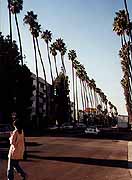
Santa Monica Sideshow
|
Today I spent the day in the family court building in Los Angeles.
I was the guest of my father’s boyhood friend Aaron Ruben who
had fascinated me with stories about his work for CASA (Court
Appointed Special Advocates). CASA started about twenty years
ago when a judge discovered that the bureaucrats at family court
knew little about the children in one case. The judge put out
a call for volunteers to be advocates for children in court situations,
to be on their side, looking after their very individual needs
and interests. He got many volunteers and the organization was
born. CASA is now found all over the nation.
How much do we need special advocates for children? Here are the
horrific US statistics. Every day 8200 children are reported as
abused, neglected, or abandoned. Every day 500 children are placed
in foster care or institutions. Every day 3 children die from
physical abuse.
If you want to be a CASA volunteer, you undergo training in legal
procedures and counseling and child development. Working under
a CASA director, a CASA member will be assigned several children
(only one CASA person I’ve heard of had more than four children).
CASA deals with situations in which children have been abused,
neglected or abandoned. The CASA representative meets with the
child or teenager and the social worker. And s/he advocates -
s/he watches and listens and asks questions and finds out all
s/he can about this one child and this one family. The CASA advocate
goes to meetings with the child (and family) - from PETs to court
sessions. The advocate (unlike the social worker or lawyers or
judge) has only one or two children to represent. That one child’s
interest is paramount. There are limits to the role. You do not,
for example, take the child in, but you DO make regular contact
and become the person the child can depend on. Aaron Ruben drives
to the juvenile hall facility once a week to meet with his CASA
boy (the only regular visitor the boy has). Today Aaron was delivering
several boxes of stuffed animals to the court to be given to children.
The family court building is new. In the past, children whose
parents were abusive or absent would wait to see a family court
judge, and sit next to mass murderers and arsonists in the one
court building. This building was designed with the children and
their needs in mind. You enter the huge building through a small
houselike space. There IS a search and no cameras or guns etc
are allowed. The lobby has clouds on the ceiling, whimsical trees
for lightstands, and a mural made up of crayoned self-portraits
of children. The second floor is where children wait for their
cases to be called. They have a large library with a variety of
books, an art room with a variety of materials, a cafeteria, a
large TV room with many beanbag chairs, lockers to put valuables
in. There are staff people available for help and comfort . The
space is large and bright and clean and quite charming .
Upstairs on the courtroom floor there were hundreds of people
waiting in the large lobby. Again the space was bright and warm
and comfortable with a variety of chairs (some child sized), and
small conversation arrangements. There are diapering rooms and
nursing rooms! There were kids of all ages from teenagers to new
babies. The adults ranged from foster parents to parents and grandparents,
CASA representatives, lawyers etc.
I visited Judge Emily Stevens’ court. The family court courtroom
is smaller and more “rumpled” and intimate than criminal court.
The judge sits at a low desk (again so children will not be intimidated).The
witness chair (where a child may sit) has a few teddy bears on
it. There are tables and desks for many court officials. I saw
a room abustle with quiet activities, both dignified and somewhat
informal. Judge Emily Steven is a bright, efficient, and compassionate
Afro-American. While she and the other officials care deeply about
the children and family in the cases they hear, numbers are against
them. Judge Stevens’ court hears about forty cases a day - It
makes it difficult to take a thoughtful, thorough time to determine
a child’s interests. This suggests how important a CASA worker
can be.
I went to a meeting of CASA workers on the topic of independent
living. There is an independent living program (federal) focused
on teenagers sixteen and older. How do you move kids from foster
care to independent apartments? There is some housing available
now but just not enough. Many of the CASA workers said their teenagers
were on waiting lists. One girl had waited eighteen months for
an apartment. In the mean time they may have to stay in shelters
or group homes. People will only be supported in foster home until
they are 18.
YAY FREEPORT: You’ll see why we should congratulate our school,
Mrs. Wescott, Mr. Lincoln, Mrs. Smith!!
The CASA director described the NEW AMAZING federal Independent
Living Program. The federal government gives money to community
colleges to run special courses to prepare kids for independent
living. Students are paid and given transport to the classes.
They are taught to manage a checking account, shop, cook, pay
bills, read a lease. They are given career guidance and vocational
testing and have job fairs and college fairs. They must collect
important documents such as birth certificates. I proudly put
my hand up and said that my high school offered all these services,
we took kids to college fairs and had an Independent Living course
for seniors and an extensive career planning program. I asked
whether it wouldn’t make better economic sense to pressure the
California legislature to put in a graduation requirement for
independent living courses than to set up new ones at community
college. Several speakers said that wouldn’t help or reach the
dropouts (true). I still found myself really proud of all the
Freeport staff does to get students ready for adult life.
I heard many stories about children and teenagers in court care
and some are hair-raising. One CASA worker said that he questioned
the current stress on keeping families together as THE top priority.
He had CASA kids who went through horrors- ten foster homes in
a year ! - while the court tried to reconstruct the family (get
the parents into drug rehab and counseling). Must we accept the
fact that some families CAN’T be put together? It sounds as though
Maine has all the same problems, but small scale.






